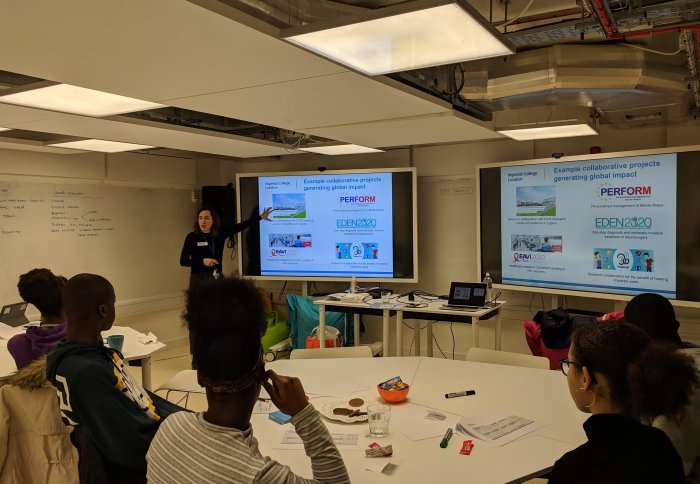Research Project Management (RPM) office spends the day with future STEM Leaders

Dr Marta Archanco speaking with students from Generating Genius about the RPM office and EU-funded research projects
RPM had a great day with high-school students from the Generating Genius Programme – a charity propelling under-represented groups into STEM careers
What a blast it was to be part of the Generating Genius (GG) visit to Imperial College London. As part of the week-long visit Dr Marta Archanco along with Siobhan Markus from the Research Project Management office, spent a day with 8 high-school students from the Uni Genius programme.
GG is a charitable organisation working with young people who are underrepresented in higher education particularly in STEM; this includes females, and ethnic groups who are generally from low-income households and most probably the first in family to go to university (Generating Genius, 2019). With university visits as part of the programme, it came as no surprise that the GG team came to Imperial to check-out the STEM initiatives and innovations Imperial are driving. Marta and Siobhan took students on a deep-dive into current EU-funded research projects and dared them with a design challenge. The challenge was indeed accepted and thrown back with interest with their project management skills. A well-deserved win which was followed-up with a behind-the-scenes tour of the Natural History Museum’s entomology department!
The day kicked off with Director of Enterprise, Dr Simon Hepworth mapping out a brief history of Imperial and its STEM innovations. Marta and Siobhan then took the students on a deep-dive into what it is like to manage transcontinental research projects. Looking to case studies within the Research Project Management office such as EDEN2020 and 3D Tune-In, the students were challenged to take to market a cutting-edge innovation in fabric and textiles – a shirt that will last forever! The students did a fantastic job in brand and design and exploring the societal, cultural, political and scientific implications of a revolutionary invention. Marta and Siobhan were so impressed with the way the students worked in a team and felt energised by their creativity, unique perspectives, and scientific prowess.

Marta and Siobhan also took the students to meet Craig Henry from the Dyson School of Design Engineering who was part of the technology team lead by Dr Lorenzo Picinali that developed 3DTune-In - an EU-funded project aimed to empower hearing-impaired communities with controlling their own hearing with a web-based audio library simulation (Toolkit) and online/mobile apps. The students experimented with the simulation and experienced how difficult it can be to have a hearing impairment especially with understanding competing sounds in a noisy environment.

The day wrapped up with a back-stage pass to the Natural History Museum’s entomology department. Students were surrounded by millions of insect specimens as resident research scientist Dr Andrew Polaszek took them through diverse collections not currently available for public viewing. Along with Dr Polaszek was EDEN2020’s biomedical engineer, Marlene Pinzi who showed the students how a wasp’s stinger inspired the design and development of a catheter for neurosurgery. Another EU-funded project, EDEN2020 is about mimicking the steerable stingers and creating a needle that can be steered with a robotic system; delivering life-saving cancer treatment to impervious areas in the brain.

Much like these projects, since its beginning in 2003, the GG programme is about impact. According to their website, since August 2018, 65% of the 400 alumni are currently at university studying a STEM degree and 12% are in full-time employment in the STEM sector (Alumni Genius, 2019). To be part of this impact was uplifting for all with Dr Simon Hepworth noting “it was inspiring to see the next generation of scientists and entrepreneurs in action!”. Siobhan Markus learned a lot from these hard-working students and says she “looks forward to welcoming the next lot of GG students to Imperial, whether that be as a student or the next leading STEM researcher at Imperial!”.
Article text (excluding photos or graphics) © Imperial College London.
Photos and graphics subject to third party copyright used with permission or © Imperial College London.
Reporter
Siobhan Markus
Enterprise